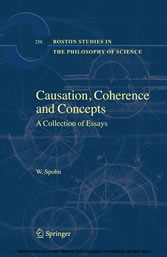Suchen und Finden
Preface
7
Contents
12
Introduction
16
Belief
31
Ordinal Conditional Functions: A Dynamic Theory of Epistemic States
32
1.1 Introduction
32
1.2 Simple Conditional Functions
35
1.3 A Problem with Simple Conditional Functions
38
1.4 Ordinal Conditional Functions
41
1.5 Conditionalization and Generalized Conditionalization
43
1.6 Independence and Conditional Independence
46
1.7 Connections with Probability Theory
50
1.8 Discussion
51
Causation
55
Direct and Indirect Causes
56
2.1 Introduction
56
2.2 The Conceptual and Formal Framework
57
2.3 Direct Causes
61
2.4 The Circumstances of Direct Causes
64
2.5 The Difficulties with Indirect Causation
68
2.6 Causation
77
Causation: An Alternative
86
3.1 Introduction
86
3.2 Variables, Propositions, Time
87
3.3 Induction First
89
3.4 Causation
95
3.5 Redundant Causation
100
3.6 Objectivization
105
Bayesian Nets Are All There Is to Causal Dependence
109
4.1 Introduction
109
4.2 Causal Graphs and Bayesian Nets
109
4.3 About the Causal Import of Bayesian Nets
113
4.4 Actions and Interventions
118
Causal Laws are Objectifications of Inductive Schemes
122
5.1 Is Causation Objective?
123
5.2 Induction
125
5.3 Causation
129
5.4 An Explication of Objectification
131
5.5 The Objectification of Induction and Causation
135
5.6 Outlook
142
Laws
144
Laws, Ceteris Paribus Conditions, and the Dynamics of Belief
145
6.1 Preparations
145
6.2 Ranking Functions
148
6.3 Laws
151
6.4 Other Things Being Equal, Normal, or Absent
155
6.5 On the Confirmation of Laws
158
6.6 Some Comparative Remarks
160
Enumerative Induction and Lawlikeness
163
7.1 Introduction
163
7.2 Ranking Functions
165
7.3 Symmetry and Non-negative Instantial Relevance
169
7.4 Laws
172
7.5 Laws and Enumerative Induction
175
7.6 The Apriority of Lawfulness
180
Chance and Necessity: From Humean Supervenience to Humean Projection
182
8.1 Introduction
182
8.2 Chance-Credence Principles
186
8.3 The Admissibility of Historic and Chance Information
190
8.4 The Admissibility of Chance Information and Humean Supervenience
194
8.5 Humean Supervenience
198
8.6 Projection Turns the Principal Principle into a Special Case of the Reflection Principle
201
8.7 Humean Projection
206
8.8 Appendix on Ranking Functions and Deterministic Laws: The Same All Over Again
210
Coherence
213
A Reason for Explanation: Explanations Provide Stable Reasons
214
9.1 Introduction
214
9.2 Induction and Causation
215
9.3 Causation and Explanation
220
9.4 Reason and Truth
226
9.5 Explanations and Stable Reasons
232
Two Coherence Principles
238
10.1 Introduction
238
10.2 Reasons
239
10.3 Two Coherence Principles
241
10.4 Justifying the Coherence Principles via Enumerative Induction?
245
10.5 Justifying the Coherence Principles via the Essence of Propositions?
246
10.6 Justifying the Coherence Principles via Consciousness?
247
10.7 Justifying the Coherence Principles via a Theory of Perception
251
How to Understand the Foundations of Empirical Belief in a Coherentist Way
256
11.1 Introduction
256
11.2 Belief, Belief Change, Reasons, and Apriority
257
11.3 Dispositions and Reduction Sentences
260
11.4 A Thesis Concerning the Basis of Empirical Beliefs
262
11.5 Defending the Thesis
264
11.6 The Foundationalist’s Last Resort?
267
Concepts
269
A Priori Reasons: A Fresh Look at Disposition Predicates
270
12.1 Introduction
270
12.2 Beliefs and Reasons
271
12.3 Kant, Kripke, Kaplan and Beliefs A Priori
273
12.4 Disposition Predicates and Reduction Sentences
278
12.5 Normal Conditions and A Priori Reasons
280
12.6 The Categorical Base of a Disposition
283
12.7 Outlook
285
The Character of Color Terms: A Materialist View
287
Concepts Are Beliefs About Essences
307
14.1 Introduction
307
14.2 The Problems Specified
309
14.3 How to Define Concepts: A Proposal
315
14.4 Explanations
319
14.5 Individualism Rescued?
326
Changing Concepts
331
The Intentional Versus the Propositional Structure of Contents
336
16.1 The Thesis
336
16.2 Stage Setting
338
16.3 The Dialectical Background of the Thesis
343
16.4 Two Arguments for the Thesis and an Objection
347
16.5 The Method of Sufficiently Fine-Grained Descriptions
354
16.6 Some Afterthoughts
359
Bibliography
361
Name Index
376
Subject Index
380
Alle Preise verstehen sich inklusive der gesetzlichen MwSt.









